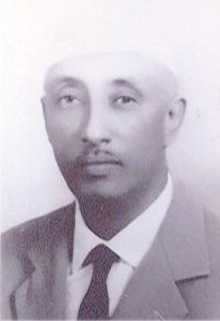Haji Bashir Ismail Yusuf
| Haji Bashir Ismail Yusuf حاجي بشير اسماعيل يوسف | |
|---|---|
 | |
| Minister of Health and Labour of the Somali Republic | |
| In office 1966–1967 | |
| Prime Minister | Abdirizak Haji Hussein |
| President of the Somali National Assembly | |
| In office July 1, 1960 – mid-1960s | |
| Prime Minister | Abdirashid Ali Shermarke |
| Preceded by | Office established |
| Succeeded by | Jama Abdullahi Qalib |
| Personal details | |
| Born | 1912 Hobyo, Somalia |
| Died | (aged 72) Cairo, Egypt |
| Political party | Somali Youth League |
| Religion | Islam |
Haji Bashir Ismail Yusuf (Somali: Xaaji Bashiir Ismaaciil Yuusuf, Arabic: حاجي بشير اسماعيل يوسف) (b. 1912 in Hobyo, Somalia – d. 1984 in Cairo, Egypt), also spelled Hagi Bashir Ismail Yousuf, was a Somali politician. He was a prominent Somali Youth League (SYL) member, and the first President of the Somali National Assembly during the Somali Republic's early civilian administration.
Personal life
Early years
Yusuf was born in 1912 in the town of Hobyo (Obbia), situated in the north-central Mudug province of Somalia.[1] The city and larger region were at the time ruled by the Sultanate of Hobyo, established by Sultan Yusuf Ali Kenadid.
Yusuf hailed from the Majeerteen sub-clan of the Harti Darod.[1]
Family
Yusuf's daughter Saida Haji Bashir Ismail later also entered politics. She served as Vice Minister of Finance in the Transitional National Government (TNG) between 2000 and 2004.[2] His son Abdullahi Haji Bashir Ismail is a Deputy Director-General of Somali Immigration and Naturalization, as well as a writer of politics and history.[3] Additionally, Yusuf was also a relative of the Somali-Italian actor and musician Jonis Bashir.
Career
Yusuf was a prominent member of the Somali Youth League (SYL), the country's first political party. He joined the organization in 1943,[1] when the SYL was founded as the Somali Youth Club (SYC). The SYL's nationalist constituents were strongly influenced by the religious rebellion at the turn of the 20th century of Mohammed Abdullah Hassan ("Mad Mullah").[4]
In an administrative capacity, Yusuf initially worked in the parliament of the Trust Territory of Somaliland as an MP (Deputato) for the northeastern town of Bosaso. The area was previously ruled by the Majeerteen Sultanate (Migiurtinia).[1] He was also part of a six member Somali Youth League delegation who made an appeal for early independence before the Four-Power Commission.[5]
On July 1, 1960, Somalia's independence day, the Somali National Assembly headed by Yusuf approved the act of union, joining the Trust Territory of Somaliland (former Italian Somaliland) with the former British Somaliland protectorate. This established the Somali Republic, and Yusuf began serving as the first President of the Somali National Assembly. He was succeeded in office by Jama Abdullahi Qalib.[1]
From mid-1960 to mid-1966, Yusuf was elected a Vice-President of the Somali National Assembly, where he worked alongside Ahmed Gumanc.[6]
Yusuf was subsequently appointed Minister of Health and Labour in 1966. He formed a key part of the Somali Republic's early civilian administration.[7]
After a long career in Somali politics, Yusuf eventually retired to Cairo, Egypt. He died there on January 2, 1984, at the age of 72.[1]
See also
- Yasin Haji Osman Sharmarke
- Abdirizak Haji Hussein
- Osman Haji Mohamed
- Abdulrahim Abby Farah
- Haji Yusuf Iman Guled
Notes
- ↑ 1.0 1.1 1.2 1.3 1.4 1.5 "H. E. Hagi Bashir Ismail Yousuf". Puntlandi. Retrieved 12 May 2013.
- ↑ "Wasiirka 1aad oo magacaabay intii ka hartay Golihiisa Wasiirrada". Banadir. Retrieved 28 June 2013.
- ↑ Ismail, Abdullahi Hagi Bashir. "Markii ugu horeysay magacyadii guddigii mideynta soomaaliya". Puntland News. Retrieved 28 June 2013.
- ↑ I. M. Lewis, A pastoral democracy: a study of pastoralism and politics among the Northern Somali of the Horn of Africa, (LIT Verlag Münster: 1999), p.304.
- ↑ Ali, Salah Mohamed (2005). Huddur & the history of Southern Somalia. Nahda Bookshop Publisher. p. 391. Retrieved 14 February 2015.
- ↑ Foreign Broadcast Information Service, Daily report: People's Republic of China, Issues 192-214, (Distributed by National Technical Information Service: 1968), p.68.
- ↑ Europa Publications Limited, The Middle East and North Africa, Volume 13, (Europa Publications.: 1966), p.570.
References
- "H. E. Hagi Bashir Ismail Yousuf". Puntlandi. Retrieved 12 May 2013.
External links
- "Sixid iyo baadhitaan taariikhda soomaaliyeed". Somali Voice. 18 May 2011. Retrieved 28 May 2013.